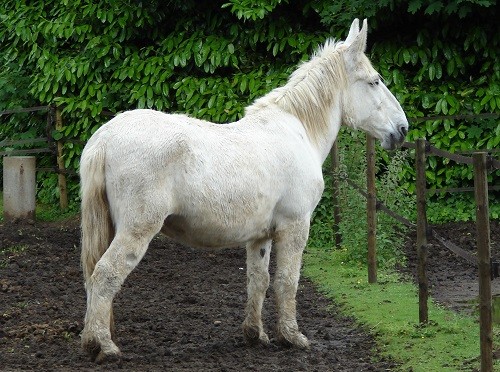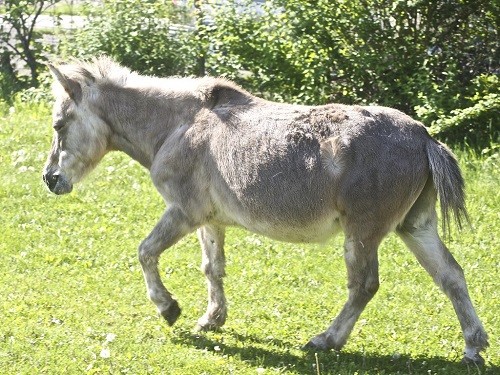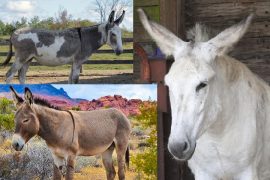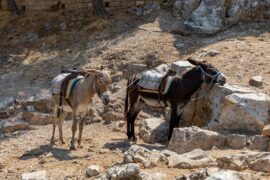Experimenting with breeding techniques has been in practice since the olden times, and mules and hinnies are the results of some of those experiments. Mules and hinnies both are the offspring of cross breeding donkeys and horses. But the factor that makes them different lies in the gender of their parents. Mules are created when a female horse is bred with a male donkey, whereas a hinny is the child of a female donkey and a male horse. Read on to find more on the differences between a mule and a hinny.
Difference Between a Mule and a Hinny: Appearance
Since both mules and hinnies are the kids of donkeys and horses, when it comes to telling them apart, it becomes a bit different. In a way, you can say that they have more similarities than differences in case of appearance. Even then, there are some significant differences between a mule and a hinny that you can spot by looking at them.
Mules, which are the offspring of a male donkey and a female horse, mostly resemble horses in appearance but with longer ears. Their manes and tail also are sparse, like that of horses. But their muscles tend to be smoother than horses, which comes as an advantage, increasing their endurance. This makes them capable to do the physical labor and adds strength to do more work than what their size allows. Their hooves are similar to horse hooves.

Hinnies, the offspring of male horses and female donkeys, are smaller in size than mules and their heads resemble more of donkeys. Their manes are thicker, and ears are shorter as compared to mules. Their legs also tend to be stronger, and hooves resemble that of donkeys.

One easy way to identify a mule from a hinny is by analyzing their patterns of making companions. When released to a herd, a mule will go towards horses, since they were raised by horse mothers. Whereas hinnies will gravitate towards donkeys as a donkey mother took care of it and brought them up.
Do Mules and Hinnies Behave Similarly?
In mules, you could find the best qualities of a horse and a donkey. They are very strong and have the athletic abilities of horses. This combined with the intelligence of donkeys, makes them agile and sensible creatures. They are friendly and fun to be around as well. Their extraordinary endurance and strength make them the perfect work animal, while their calm and patient nature helps with training and managing them. Similar to donkeys, mules encourage an environment where they are treated well. This happens because they are more intelligent than horses.
When it comes to hinnies, their behavioral patterns closely resemble that of donkeys. They are less adventurous when compared to mules and are more meticulous than them. This makes them slower. They are friendly, easy-going, and mellow and can easily navigate through steep and rocky terrains. Their greater endurance helps them take such situations more calmly than mules. Another difference between a mule and a hinny is that hinnies are much more suited for remote areas with less vegetation than mules. They do not have much in particular when it comes to food and can happily survive on less nutrition, according to the climate.
Why were Mules and Hinnies Created?
Hybrid breeds are produced by picking the most desirable characteristics from the parents involved for increased efficiency and productivity. And mules, since they carry in them the strength of horses with the intelligence of donkeys, make the perfect animal for farm work. Their less requirement of food and adaptability to different climates also make them desirable to a great extent. And these were the reasons for producing mules, and the history of mule breeding too runs far long back.
But when it comes to hinnies, they are far less in numbers than mules. Most often a hinny is not even known to many people out there. Though they are friendly and calm animals, the conception of hinnies is often accidental and not planned by the farm owners. This does not mean they are lousy or clumsy animals on the farm. They have greater endurance than mules and are compliant animals that are easy to train as well.

Training Mules and Hinnies
Though both mules and hinnies are produced by donkeys and horses, their training and care do not exactly follow that of their parents. Since hinnies are raised among donkeys and mules among horses, hinnies are easier to train and manage than mules. Still, training them is not a big task, and is achievable with a little effort.
Their training does not follow the techniques that are adopted while training horses. This is because these animals are more intelligent and self-persistent than horses. And this, at times, gives them the label “stubborn” especially in the case of mules. Building your trust and creating a bond before training them would be a good approach, as being harsh with them is not the right way to deal with them. If you treat them well and with respect, the training sessions would be a fruitful experience and fun activity.
What are Mules and Hinnies Used For?
Apart from being pack animals, for which they have been in use for ages, mules and hinnies make good companion animals and riding animals. Since hinnies are small in size, they are often bred with miniature horses, creating small pets that are cute and a delight for horse lovers. They are also used for competitions, especially riding events, for which they have very high demand.

Can Mules and Hinnies Reproduce?
A common problem that equine hybrids face when it comes to reproduction is that they are, at most times, sterile, and unable to reproduce. The cause of this problem lies in the chromosome numbers of their parents. While horses carry 64 chromosomes, donkeys only have 62 of them. And when a mule or hinny is born, they are born with just 63 chromosomes, which affects their fertility. Thus, all hinnies are often sterile, whereas there have been times, very rarely, when mules were able to reproduce.
Conclusion
Mules and hinnies are both excellent hybrids that have been part of human civilization for a long time. Though different from their individual parents, horses, and donkeys, these hybrids carry the most desirable qualities of them. So, if you are planning to get a mule or hinny, now you know how they are different; now you can choose the right one for you.

![What are the Differences Between a Mule and a Hinny? [Which is Better?] difference between a mule and a hinny](https://donkeyonfarm.com/wp-content/uploads/2023/08/difference-between-a-mule-and-a-hinny.jpg)



![What Are Mules Used For? [How Are They Better?] what are mules used for](https://donkeyonfarm.com/wp-content/uploads/2023/08/preview16_11zon-270x180.jpg)
![7 Large Donkey Breeds That You Should Know [With Pictures] large donkey breeds](https://donkeyonfarm.com/wp-content/uploads/2023/07/ass-1220250_1280_11zon-270x180.jpg)